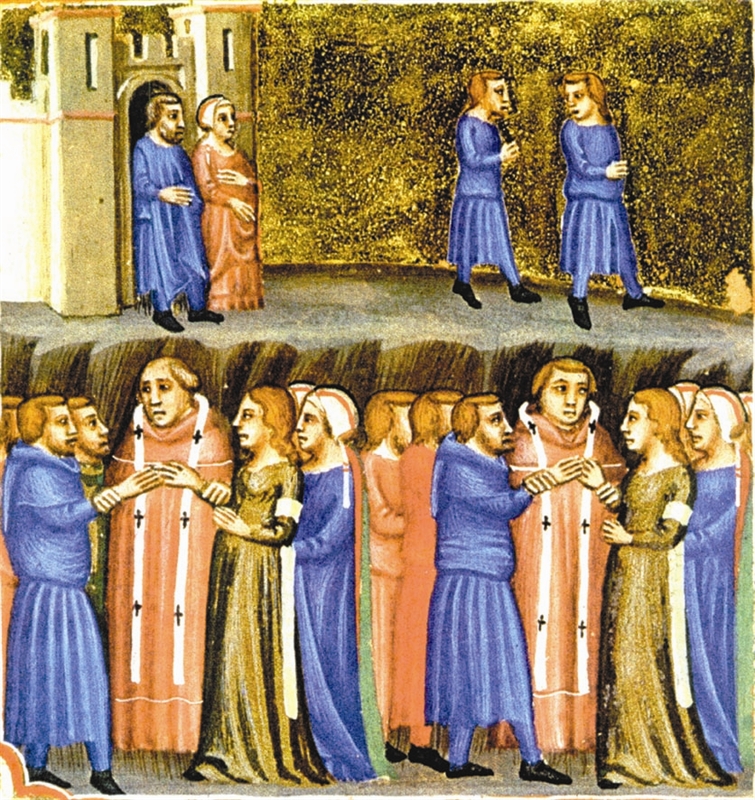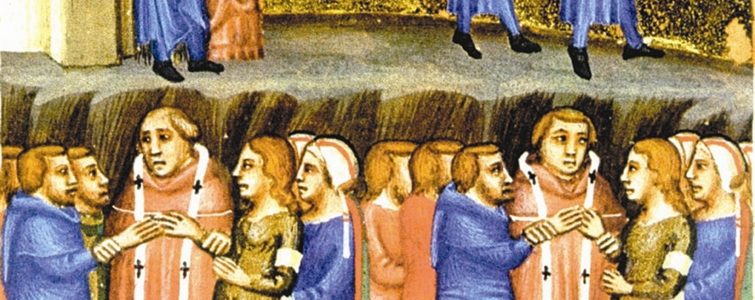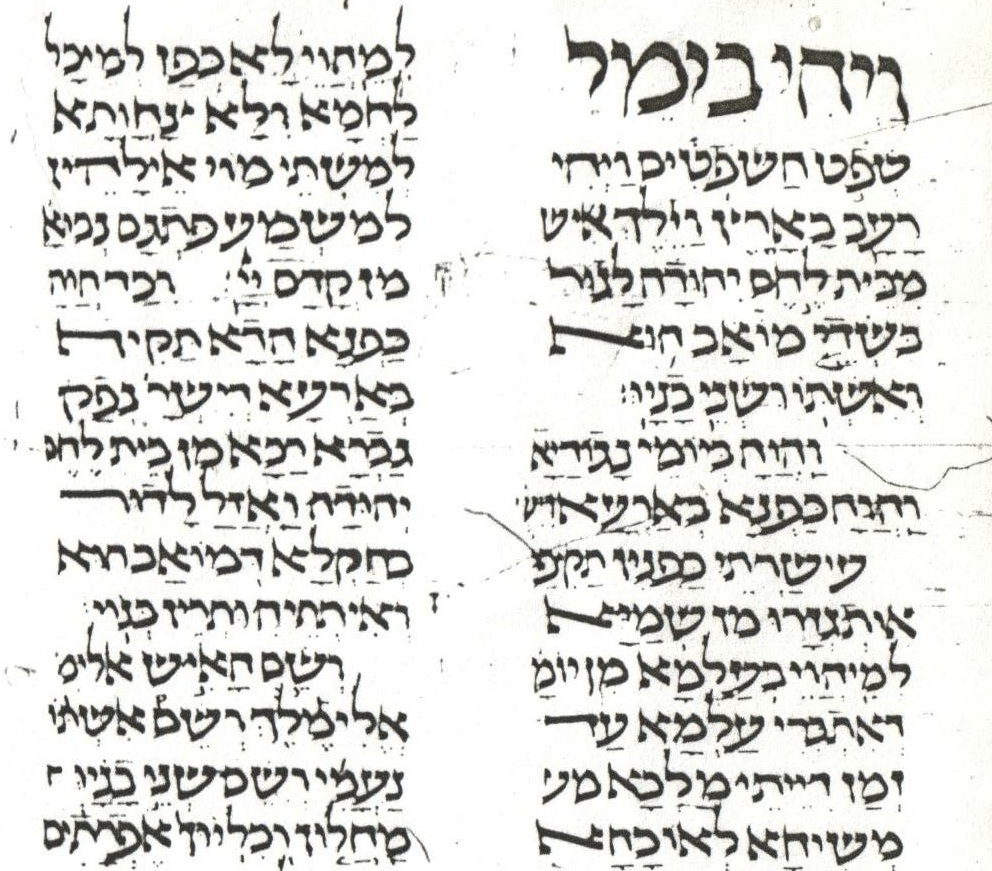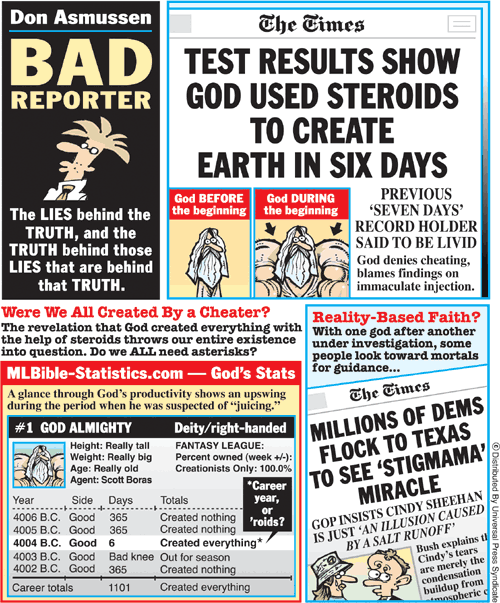
Illuminated Naples Bible (Ms. 1191, f.97v): Wedding of Machlon and Chilion
In the upper section, Naomi and Elimelech stand at the gate of Bethlehem as their sons Mahlon and Chilion leave. In the lower section, Mahlon and Chilion are married to Ruth and Orpah.
Other resources for the Book of Ruth, including a short commentary, and its Targum can be found by navigating the menu above.
Last month [July 2012] I presented my paper on the conversion of Ruth in Targum Ruth. [mfn]NB: This was originally posted in August 2012, but it is my most frequently visited essay so over the years I have taken time to tweak and flesh out some of the content.[/mfn] I noted, in passing, that the Targum also explains why the two sons/husbands died in Moab. A reminder of the biblical text:
Ruth 1:1 In the days when the judges ruled, there was a famine in the land, and a certain man of Bethlehem in Judah went to live in the country of Moab, he and his wife and two sons. 2 The name of the man was Elimelech and the name of his wife Naomi, and the names of his two sons were Mahlon and Chilion; they were Ephrathites from Bethlehem in Judah. They went into the country of Moab and remained there. 3 But Elimelech, the husband of Naomi, died, and she was left with her two sons. 4 These took Moabite wives; the name of the one was Orpah and the name of the other Ruth. When they had lived there about ten years, 5 both Mahlon and Chilion also died, so that the woman was left without her two sons and her husband.
In the Bible we are given no explanation for why Elimelech’s sons died. We might make various inferences such as relating it to their having moved out of the Promised Land and marrying not simply foreign wives but specifically Moabite women (see Deut. 23:3). We might make such interfaces, but the biblical text offers no explanation. Such ambiguity is often the case in Hebrew narrative texts, allowing room and opportunity for the reader to engage with the text or, perhaps, simply not concerned with issues that later readers found important.
The Targum of Ruth, like all Targumim, is expansive and seeks to answer many questions that the Targumist felt lacking in the biblical text. In this case, the opening portion provides a specific answer to why Mahlon and Chilion died.
Tg. Ruth 1:4 They [Mahlon and Chilion] transgressed the decree of the Memra of the Lord and they took for themselves foreign wives from the house of Moab.
After my paper, a man came up to me and asked where this was in the Targum, since he had never read such a judgment in rabbinic literature. Now, I did not know the man so I do not know his experience or expertise and I do not claim to have complete or thorough knowledge of all rabbinic haggadah but I was fairly confident it was at least in Ruth Rabbah. Sure enough, not only is it in the Targum of Ruth, it is also in the Midrash.
Ruth R. II:9. AND THEY TOOK THEM WIVES OF THE DAUGHTERS OF MOAB (1, 4). It was taught in the name of R. Meir: They neither proselytised them, nor gave them ritual immersion, nor had the new law, Ammonite, but not Ammonitess, Moabite, but not Moabitess, been propounded, that they should escape punishment on its account. [mfn]Rabinowitz, Louis I. Midrash Rabbah: Ruth. London: Soncino, 1939.[/mfn]
R. Meir, according to the Midrash, taught that Mahlon and Chilion “should not escape punishment” since the exceptions to the biblical law, including conversion, had not yet been promulgated in the time of Elimelech and his sons and therefore they died. It seems to me that the Targum is simply making explicit what is implicit in Ruth R. II:9.
Now this creates a separate problem for the Targumist which may explain why the other rabbinic commentaries side-step this explanation of Ruth 1:4. Once it is declared that M & C have been killed because they took Moabite wives, how can Boaz take Ruth to be his wife? Surely he would suffer the same fate! Again, it is worth noting that Ruth’s status as a Moabite in relation to Deuteronomic Law is not addressed in the biblical text, something that scholars have debated for centuries (e.g., did the author of Ruth even know of Deuteronomy?). The Midrash alludes to the answer in reference to the “new law” and the Targum makes it explicit in Targum Ruth 2:11.
11 Boaz replied and said to her, “It has surely been told to me concerning the word of the sages that when the Lord decreed concerning them he did not decree against any but the men.
So the Targumist explains why M & C died, but Boaz did not. Why is this discussion important? Because dating rabbinic texts is difficult and dating Targumic texts even more so. One method is to try and determine which exegetical tradition is older and who is borrowing from whom. If the Targumic reading of 1:4 is new or unique or even in conflict with other rabbinic traditions, that might be helpful in determining its date. Or not.
Note that in contrast with the Targum, in the Talmud (b. B. Bat. 91a) it is stated that the “sin” of Elimelech and his family was “to go forth from Palestine to a foreign land” before all supplies and options were exhausted. It does not mention the taking of Moabite wives, but rather places the emphasis upon the lack of faith that God would provide for them in their time of famine and need.
IMAGE: I found this great image at “The Visual Midrash” [the link is now dead]. I have found a PDF of a publication of the MS on Archive.org. I don’t believe it contains all the images. I need to do more research into this MS; it is beautiful. It is fascinating that there is a Christian priest officiating this wedding (note the crosses on the stole)! A whole new realm of “wrong” as far as the unions of Mahlon and Chilion to their non-Jewish brides.





24 thoughts on “Why did Mahlon and Chilion die? According to the Targum”
Dear Christian,
How interesting that this should come up!
This past sunday in Sunday School here at Faith Community Church in Redding, CA the class was dealing with the Book of Ruth. In the discussion we came upon 1:4 dealing with the death of Elimelech, Mahlon and Chilion (Kilion).
As the teacher I pointed out the following:
1) Deuteronomy 23:3ff is quite clear about allowing Ammonites and Moabites into the congregation of Israel. In other words, the Israelites are NOT to marry outside of nation of Israel. Elimelech, as the parental head violated that commandment along with Mahlon and Chilion. Intermarriage with the Canaanites was also forbidden.
2) It is by the grace of God that saw Ruth accept the God of Israel as her God over against the gods of the Moabites (especially the god Molech/Chemosh). The same could also be applied to Tamar, Rahab, and later, Bathsheba.
3) Boaz did not let the grass grow green under his feet in seeking the hand of Ruth (chapter 4).
I would add the following to that which I did not know until today
4) In an article referenced by Dr. Claude Mariottini in Israel Today Magazine,”A Messianic Interpretation of Genesis 2:4,”
(http://israeltoday.co.il/NewsItem/tabid/178/nid/23351/language/en-US/Default.aspx.), Jewish rabbinic interpretation links Genesis 2:4 with Ruth 4:18 based on the plene reading of “toledoth.”
“The plene spelling toledot (generations) in Genesis 2:4 appears
only here and Ruth 4:18, the latter verse stating “this is the
genealogy (toledot) of Perez.” According to Jewish commentators, this
unique spelling is that which links the two genealogies and
juxtaposes Adam with the Messiah, the son of Perez.”
Interesting how this fits in with your post today.
Thanks Bryant! I am glad you found this interesting.
I think there are still reasonable questions as to whether we ought to see Ruth as “converting” (making a clear commitment to accept YHWH over and against other gods) or simply the more common ancient practice of simply accepting that now that she would be in Israel she would worship the Israelite god. Later traditions, both Jewish and Christian, of course make this into a full conversion. In fact, that is my most recent article that I am just shipping off this week.
As for Boaz “not letting the grass grow” he certainly did not once Ruth acted! But as I point out in another article and some posts here (as have many others), Boaz takes very little initiative with regards to Ruth, or Naomi for that matter. He knows that she is present and in need (chapter 2) but the only action he takes is to allow Ruth to safely glean. It requires the cunning of Naomi and the action of Ruth to goad him into taking the next steps.
Finally, TgRuth also adds information to the genealogy at the end of Ruth:
Christian,
I Mahlon and Chilion died because they married Moabitesses, Boaz was not under the same restriction because his mother Rahab was an Ammorite and so he was separated from the congregation of the Lord by 9 rather than 10 generations. Long ago I wrote an article showing the geneologies between Ruth and David were abbreviated because of this requirement.
Brace and peace,
Bruce
Bruce, You make a good point about the New Testament identifying Boaz’s mother as Rahab (Matt. 1:6). It is a tradition, however, that is only maintained in that one source and I know of no Jewish source that preserves that interpretative tradition. There is nothing in the Book of Ruth to make the connection; Boaz’s lineage is simply expressed as being a מידע, a “kinsman” of the family of Elimelech (Ruth 2:1). There is no mention of Rahab and while I am firm advocate that the silence of the Bible on such details is usually just that, silence, if such a detail were known to the author I might have expected it to be shared.
Further, if the Matthew tradition had basis in historical fact, it raises other difficulties. That would mean that Elimelech’s family was ALSO descended from Rahab and thus would also be under the same lack of constraints that you assign to Boaz. In other words, if Boaz was eligible to marry a Moabitess due to his lineage then so could Elimelech’s sons. Where they are in lineage is not really relevant since the reference in Deut. 23:3 to the “tenth generation” is another way of saying “forever,” as is evident in the clause that follows, “none of their descendants shall be admitted to the assembly of the LORD.”
Awesome
So what real answer for the cause of the death of mahlon and chilion
It depends upon what you mean by “real answer.” The Book of Ruth does not offer an answer. It simply states that they died. As noted above, the rabbinic commentators and others assume that they died because they transgressed the law found in Deut. 23:4 [Engl. 3] states, “No Ammonite or Moabite shall be admitted to the assembly of the LORD.” “Admitted to the assembly of the LORD” is understand as meaning marriage in this context.
Given that Boaz does NOT die when he marries Ruth it seems likely to me that the author of the Book of Ruth simply did not want to explore the cause of the sons’ deaths and rather focus instead upon Ruth’s full inclusion into Israel.
Interesting read. Unfortunately, no one here looks into the text of Ruth 1:4 to its extent…”and they lived there about ten years….1:5 “then both Mahlon and Chilion died,” I agree that the rabbinic commentators ASSUMED they died because of the law, but the commentators in no way give a reasoning as to why they died ten years later. In saying that, I believe that the best conclusion is to not to assume a reason for their death and be satisfied with just knowing they died.
Matt,
The purpose of this site is to have a meaningful discussion about the interpretation and meaning of the events and writings included in the Bible. The Bible is a written document transcribed from Hebrew, the same as many of the writings in the midrashes, Talmud and Sanhedrin. I think as believers, we have to give some credibility in these writings unless they completely contradict our beliefs and the documents that we think are the most critical.
Unfortunately, the majority of the Bible was written years or decades after the events occurred, making it even more difficult to have all of the facts. There is no harm in us seeking answers, or even debating potential answers, for the areas of the Bible where details are lacking. But to say that we should just be satisfied with the fact that they died is not reasonable. If that were the case, then this site would be worthless and honestly raises the question as to why you would even be here reading this commentary if your outlook was to just be satisfied with what is written.
Ruth was not an ethnic Moabite, she was an Israelite. Ruben, For over 200 years Ruben, Gad and half of Manasseh occupied all the territory north of the Arnon to MT Hermon. Part of that territory was once Moab’s but the Amorites under King Sihon took it. Moab tried to take it back and for about 18 years succeeded at least in an area. Israel fought back and its during this time that Naomi’s sons died. Boaz could not have redeemed her had she been a true Moabite. One can be an American, a Cuban, a Frenchman, etc and still be a Jew. Ruth was a Moabite Jew that like many had in Israel, worshiped the local deities but chose to do teshuva returning with Naomi.
Shoshana, that is an interesting suggestion that Ruth was an Israelite. I have not read it anywhere else and I would be interested as to where you come across this idea.
Unfortunately it is contradicted by the biblical text of the Book of Ruth. It repeatedly (and with emphasis) states that Ruth is “a Moabitess.” The distinction between ethnicity and nationality (such as you suggest for a Frenchman and a Jew) is a relatively recent conception. In fact, it is at the core of anti-Judaism throughout antiquity and into our modern era, the assumption that one could NOT be a Jew and a Frenchman (e.g., the Dreyfus Affair), American, etc.
I partially agree with both of you. I agree with Christian that it is uncontested that Ruth was a Moabitess. The Bible and all rabbinical texts that I have read state the same. I partly agree with the path that Shoshana might be heading down in that they potentially died in battle. I just don’t think she has the correct era or battle. In Rabbinical texts, there are two hints. The first is that Orpah and Ruth we’re daughters (or granddaughters) to King Eglon. The second is that Mahlon and Chilion became officers in an army. One can surmise that either they became officers in the army that Eglon commanded and more likely died during the battle with Ehud’s army after he killed Eglon and took control of the Jordan crossing, killing 10,000 moabites. The Sihon battle between the Ammorites and the Israelites occurred much earlier, in the time of Moses and Joshua around the time of the Exodus.
It is my belief that the two sons married the daughters of King Eglon, became officers in his army and died battling Ehud’s army. This all being God’s punishment for marrying pagan, unconverted, Moabitess women.
Also remember this. The family departed Judah to go to Moab. This would have been after Joshua and the tribal allotment. And that once Ehud killed Eglon, there was a period of peace peace in Israel for 80 years. When you combine this with the fact that the boys lived in Moab for ten years before they died, it is even more unlikely that they died during the Sihon battle.
So many typos that I couldn’t correct. I meant it is unlikely that they died during the Sihon battle.
Thank you for your comments Ken. I have corrected the typos in the comment above for clarity, as you requested.
It is important to remember that the biblical text of the Book of Ruth does not tell us anything about Orpah and Ruth’s background. Nothing. That is presumably intentional on the part of the author. The read knows what the author wants us to know. That does not keep us from asking questions, of course, like “why did the boys die?” That is just what the rabbis do all the time in midrash. In fact, it is the starting point of most midrashic interpretations, to find the gap or “hook” in the text on which to hang an message or interpretation. So here details from the biblical context (like the fact that it was the time of Judges) as well as suppositions (that Elimelech would have been of high standing, a “prince,” and they would have been welcomed into Eglon’s court) are built up into a structure. It is a creative exercise, but it often has a tenuous connection to the actual biblical text.
In fact, one of the primary difficulties with that particular interpretation is that Elimelech and his family were fleeing the famine. This is the foundation of the narrative of the Book of Ruth. The elite of a community were usually the last to leave in times of hardship because they would be the most well-off. They are refugees from famine, leaving their property and wealth behind. The fact that they are leaving “the Promise Land” to go to the land of the enemy is also a statement against Elimelech, the author wants us to know that, unlike the righteous Boaz, he did not trust in God’s provision in the land he had given Israel, but went to a foreign field.
Well if do give any credence to the midrashes, Talmud and other rabbinical texts, they provide a lot of information that in my opinion are not controversial, but do fill in some gaps. For example, several sources indicate that Orpah and Ruth were daughters of Eglon and that the boys actually became officers in the army (presumably Eglon’s) and may have even died at the hands of Ehud’s army. Several texts also indicate that the majority of Ruth was during a time of peace. This would rule out those that believe it was at the time of Gideon and the Midianite oppression. I like to think that the rabbinical texts were written using much of the same source material that the bible conversions utilized. I.e. Greek writings. I have experienced a lot of diverse opinions. When I teach Sunday school classes, I don’t claim that my opinion is fact, but just one interpretation of the various sources. I welcome other people disputing or challenging me, as I am certain to delve into the source material and come up with my own opinion when others lead the discussions. As a practicing engineer who taught college at Purdue, I like to see things in my mind logically and graphically as much as possible. And as long as those opinions do not interfere with the message, I think it is productive discussion. Let’s be honest. The authors did not have a great grasp of time and details so it is kind of like solving a mystery to me.
And I was talking about my typos! 😉
Thanks for the feedback.
Ken, thank you for continuing to engage! With respect to the rabbinic sources, it all depends upon what one means by “credence.” If one assumes that the events described in Ruth actually happened (not an assumption everyone holds) and if the concern is to determine historical facts about the figures in the story, then the rabbinic sources are not likely to be very credible. They are almost a millennia older than the period of the Judges and have no additional material at their disposal than we do. It can be interesting to consider what it might mean if Ruth were a princess, but there is no evidence that such was the case, just an interpretive tradition centuries after the fact.
Now, if we are interested in how the story of Ruth was interpreted throughout history within Judaism and Christianity (as I am) then those traditions are very interesting and enlightening. They tells us an immense amount about what the rabbis thought of the book and its position within Scripture. Such study can show, for example, how the figure of Ruth came to be viewed as an exemplar of the proselyte to Judaism even though it is questionable whether the Book of Ruth actually shows her as converting or not. (The passage may well be a more pragmatic statement of fealty to Naomi than a “confession of faith.”) All of that reflects what people were thinking about the Book of Ruth at that time, rather than revealing historical “truths” about the events and figures described.
Many of those commenting on this essay are interested in such historical truths or facts. What concerns me is the injudicious use of rabbinic sources to provide “evidence” of a given tradition. The passage in Ruth Rabbah, the Midrash of Ruth that says that she and Orpah were sisters and daughters of Eglon (Ruth R. ii. 9), is a source of traditional interpretation, but it is not a “source” of historical fact about Ruth and Orpah. On the other hand, an Iron Age inscription listing the two women’s names as daughters of the King Eglon would be an historical source that would be evidence of their identities (and very existence).
It is important that we distinguish between and acknowledge the nature of the material we are working with. So in our investigations it is vital that we are honest about what kind of questions we are asking of the sources and the nature of the sources themselves. If our interest is purely literary and interpretive then the rabbinic sources are incredibly enlightening. If we want to know what happened historically, bearing in mind that many doubt the historicity of the Book of Ruth, then we are engaged in a very different task and need very different kinds of sources.
What evidence have you found that is not an ethnic Moabite? The Moabites were there long before the exodus ever happened. The Moabites came from the ancestors of Lot and his daughter Moab. And if a Ruth was a descendent of Eglon, she would have to have been an ethnic Moabite.
Please explain your reasoning more as it doesn’t make sense.
Thanks.
Did both sons of naomi died on the same day
The biblical text does not say. It reads simply, “When they had lived there about ten years, both Mahlon and Chilion also died, so that the woman was left without her two sons and her husband.” (Ruth 1:4b-5a).
In reading the comments I wanted to note that on chabad(dot)org, Mendel Dubov in his video lessons on the book of Ruth claims that it is common oral tradition that Boaz died the day after he and Ruth’s wedding, after God enabled her to conceive.
God is consistent, but not predictable. For me the take home fact is that Ruth and Boaz are ancestors of Jesus (Matthew 1). God wants to show that His grace is extended to everyone, not just the physical seed of Abraham. What a wonderful, humble God that extends salvation to everyone. Even murderers (King David) and prostitutes (Rahab) are included. In the end only a heart of flesh is important (Ezekiel 11:19).